AMD’s Mobile Revival: Redefining the Notebook Business with the Ryzen 9 4900HS (A Review)
by Dr. Ian Cutress on April 9, 2020 9:00 AM EST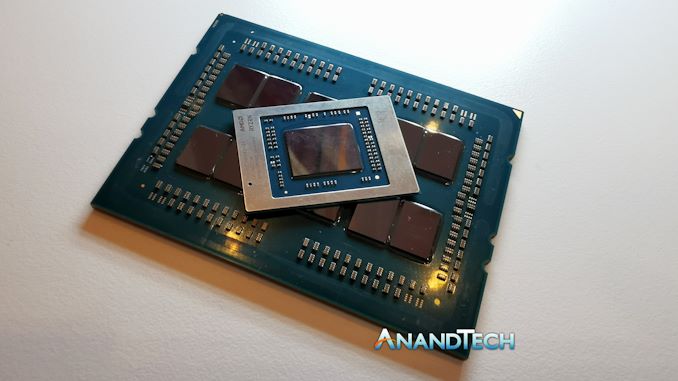
At every turn in the story of AMD’s notebook portfolio, we’ve been there to document the highs and lows. Five years ago, AMD was definitely suffering from a combination of a poor platform, and poor notebook designs tailored for the budget end of the market. Last year, AMD scored a design win in the Microsoft Surface, and now 2020 is set to be another significant step back into this market, with the new Ryzen Mobile 4000 series. Touting over 100+ design wins this year for the new 7nm processor line, we have the first of the halo products in for review: the ASUS Zephyrus G14, with an 8-core Ryzen 9 4900HS under the hood. We’re comparing it to an equivalent Razer Blade 15-inch, and it is very clear that AMD can take the lead in a lot of tests, and be very competitive in others.
The Notebook Market and Ryzen Mobile 4000
One of the strongest elements to PC market growth in recent years is the notebook market. Users have been updating their mobile PC more frequently than their desktop, especially when new form factors offer more performance in thinner and lighter designs, with new features such as faster Wi-Fi, high resolution displays, and high capacity fast storage. All of which, in turn, has lead to a push for a quicker update cycle.
These new form factor designs, like thin and lights, or 2-in-1s, are driven by high performance components that are able to run efficiently across a wide spectrum of performance levels, to deliver throughput for gaming and work when needed, or to power down to conserve power when on the road or in an airplane. The cost of these new form factor devices have come down to something more palatable for the average user, but for a good number of years, AMD’s hardware wasn’t even in this market.
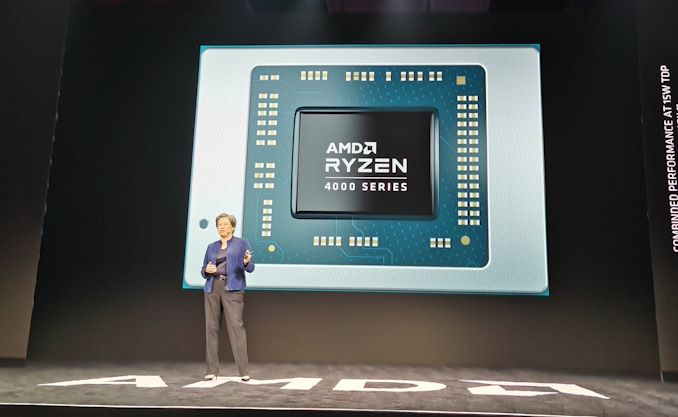
Dr. Lisa Su at an AMD Ryzen Mobile Presentation
For 2020, AMD is expecting to be at the forefront of notebook design wins, due to two main features of the new Ryzen Mobile 4000 strategy: high performance components, and co-design with OEMs. When the OEMs start spending more money on designing higher profile systems for a specific processor, like the ASUS Zephyrus G14 with a Ryzen 9 that we have in for testing, it is clear that the hardware underneath should offer something that the market wants.
In total there are eleven of AMD’s new ‘Renoir’ Ryzen Mobile 4000 CPUs, split across the 15 W and 45 W markets. The top CPUs in each offer up to eight Zen 2 cores, Vega 8 integrated graphics, and the main differences between the two sets is going to be the base frequencies.
| AMD Ryzen Mobile 4000 APUs | |||||||
| AnandTech | Cores Threads |
Base Freq |
Turbo Freq |
L2 | L3 | GPU CUs GPU Freq |
TDP |
| H-Series | |||||||
| Ryzen 9 4900H | 8 / 16 | 3.3 GHz | 4.4 GHz | 4 MB | 8 MB | 8 / 1750 MHz | 45 W |
| Ryzen 9 4900HS | 8 / 16 | 3.0 GHz | 4.3 GHz | 4 MB | 8 MB | 8 / 1750 MHz | 35 W |
| Ryzen 7 4800H | 8 / 16 | 2.9 GHz | 4.2 GHz | 4 MB | 8 MB | 7 / 1600 MHz | 45 W |
| Ryzen 7 4800HS | 8 / 16 | 2.9 GHz | 4.2 GHz | 4 MB | 8 MB | 7 / 1600 MHz | 35 W |
| Ryzen 5 4600H | 6 / 12 | 3.0 GHz | 4.0 GHz | 3 MB | 8 MB | 6 / 1500 MHz | 45 W |
| Ryzen 5 4600HS | 6 / 12 | 3.0 GHz | 4.0 GHz | 3 MB | 8 MB | 6 / 1500 MHz | 35 W |
| U-Series | |||||||
| Ryzen 7 4800U | 8 / 16 | 1.8 GHz | 4.2 GHz | 4 MB | 8 MB | 8 / 1750 MHz | 15 W |
| Ryzen 7 4700U | 8 / 8 | 2.0 GHz | 4.1 GHz | 4 MB | 8 MB | 7 / 1600 MHz | 15 W |
| Ryzen 5 4600U | 6 / 12 | 2.1 GHz | 4.0 GHz | 3 MB | 8 MB | 6 / 1500 MHz | 15 W |
| Ryzen 5 4500U | 6 / 6 | 2.3 GHz | 4.0 GHz | 3 MB | 8 MB | 6 / 1500 MHz | 15 W |
| Ryzen 3 4300U | 4 / 4 | 2.7 GHz | 3.7 GHz | 2 MB | 4 MB | 5 / 1400 MHz | 15 W |
All the 15 W CPUs are commonly referred to as the ‘U-Series’, while the 35-45 processors are known as ‘H-series’. We may use these terms interchangeably.
The Ryzen 7 15 W processors offer eight cores in that tiny thermal envelope. This means at full use, each core will only have access to under 2 W of power, and the system is still expected to be north of 2.2 GHz. We’ve seen the desktop Ryzen processors hit 3.0 GHz at under 3 W each, and these mobile parts are likely to be the best bins for power efficiency.
The 45 W processors are mainly aimed at higher throughput systems, and the first notebooks with this hardware will be paired with discrete graphics, providing systems totaling 100 W or more. For each H processor there is a corresponding HS processor, offering similar or almost similar specifications to the H processor, but at 10 W less. As mentioned above, these CPUs are ‘S’pecial in that OEMs have to work with AMD and meet specific criteria in the hardware design to be given the HS models. ASUS has an exclusive through Q2 and Q3 of 2020 on these with the Zephyrus G14, however we expect more models to come for the Christmas system. These HS systems will be part of AMD’s Continuous Validation Labs project, with a lab in Austin and a lab in Shanghai, that pre-tests any driver or software updates for compatibility before they are distributed, in order to maintain device performance.
AMD didn't just magically get here. There were a number of tough years in the last decade on its notebook platform.
2016: A Historic Low for AMD in Notebooks
Back in 2016, we reviewed five laptops concurrently, all featuring AMD’s latest mobile platform at the time, Carrizo. These systems were built by AMD’s key OEM partners at the time, such as HP, Lenovo, and Toshiba, and were aimed at the $500 to $900 market. At the time, AMD was struggling with a product that was not that good, and although was better than the previous generation, it still struggled to be competitive.
One thing that shot AMD in the foot was that AMD unified the design between its dual channel memory regular Carrizo parts and the single channel low cost Carrizo-L parts, which allowed OEMs to build regular systems with only a single memory channel to save costs. OEMs knew this crippled performance, but in enabled the headline processors in cheaper devices. These devices also ended up with low quality displays, mechanical hard drives, and were big and bulky because the user with a low budget could only afford this level of design. It ended up being a vicious circle of negative feedback – we covered the full story in a 24 page deep dive which you can read here.
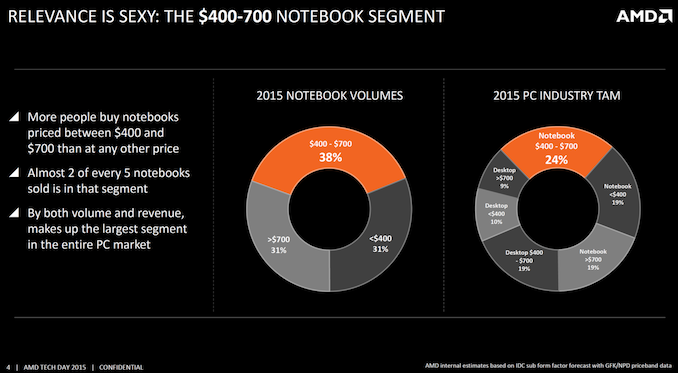
A slide from AMD in 2015, Showing the Target Markets
As part of that analysis, we provided a number of potential solutions to the problem, including the fact that AMD should design its platforms for different segments and define its own market, rather than coalescing them all into one. We also also suggested AMD should take a leap and creating proper $1500 flagship reference systems for its OEM partners to provide a basis on which higher-end designs could be built. I also suggested that the OEMs also not be cheap and look at how $10 more on SATA storage can really bump the user experience.
An overriding solution to this issue was that AMD should build a notebook processor that is not only competitive, but also aims to beat the competition. At the time of Carrizo, we were still wondering what AMD had in its sleeve – the company had started talking about Zen and returning to the high performance market and we heard promises of it also coming to the notebook form factor. The company received a lot of praise with its first generation Zen desktop product, which increased as we saw Zen 2 being launched on TSMC’s leading 7nm process node. The mobile chips by contrast have been the last of each generation to show, given that the desktop and server products take advantage of multiple chiplet designs, leveraging benefits such as increased yield and frequency binning with reduced costs, while the mobile processors are still monolithic.
The first new mobile APUs, known as Raven Ridge and Picasso, combined Zen cores with Vega graphics, on a 14nm/12nm process, and targeted the 15 W notebook market. These achieved a variety of successes, by virtue of bringing performance back to a more palatable level, and AMD’s partners using the hardware in some key important designs, such as the Lenovo Thinkpad. The Thinkpad is one of the most important wins here, because AMD has always had a lot of success in the commercial market – this is where a company might purchase 2500 laptops for their employees to work on but they also require extra layers of management and administration to get working within the corporate environment. Despite the successes, Raven Ridge and Picasso still had two key disadvantages compared to Intel’s equivalent hardware – raw performance and battery life. This was shown in one of the latest products to appear on Picasso, whereby the Microsoft Surface 3 was available in AMD and Intel formats with an identical chassis and battery size.
Our Microsoft Surface 3 Review, comparing AMD’s Picasso-based Ryzen 7 against Intel’s 10nm-based Core i7, has been one of the best A vs. B notebook comparisons in recent memory. For the 16 GB / 512 GB variants, Intel commanded a $100 premium but offered Windows 10 Pro, Wi-Fi 6 and LPDDR4X-3733 memory, compared to Windows 10 Home, Wi-Fi 5 and DDR4-2400. The overall conclusion was firmly on the side of Intel, in CPU performance, power efficiency, and battery life. But ultimately here was AMD’s big design win, a premium notebook model.
In For The Win: 2020
This brings us onto today’s new hardware. AMD’s has teased the ‘Renoir’ platform since CES at the beginning of the year, combining its new Zen 2 cores with updated Vega graphics on TSMC’s leading edge 7nm process. What surprised us for the original announcement was the depths to which AMD wanted to push a lead: up to eight cores in a 15 W design, at competitive frequencies as well. The only way for Intel to put over four cores in a laptop processor is to go up to the 45 W bracket. AMD has been presenting us with some big benchmark gains over Intel, along with a 2x increase in efficiency generation on generation and new power management technology that will remove issues that plagued the battery life on previous iterations of designs using AMD processors.
At CES, AMD boasted that the company would have a dozen Ryzen Mobile 4000 ‘Renoir’ systems on shelves within the quarter, and over 100 designs by the end of 2020. Recent world events have perhaps elongated those time spans a bit, but we did get to see what these Ryzen Mobile 4000 laptops would look like. AMD put its cards on the table and was very clear that its notebook partners were now fully onboard the Ryzen Mobile train – after successfully delivering Raven Ridge and Picasso on a regular cadence, with a lot better performance and a rise in demand, OEMs were more amenable to AMD’s roadmaps and what the performance claims are, enough to put significant resources into developing top-line halo hardware. If Microsoft were confident enough to put a Picasso in the Surface, then other OEMs should fall in line. And at CES in January, they all did, and the OEM partners were keen to show off the new AMD systems.
One of the highlights of CES was the ASUS Zephyrus G14. This device, even without it being on sale, won numerous awards from the media for exhibiting what AMD’s new platform can do. In a 14-inch chassis, the hardware combined a top line Ryzen 9 4900HS processor with 8 cores, an NVIDIA RTX 2060 with Max-Q graphics card, Wi-Fi 6, NVMe storage, and a 1080p 120 Hz IPS display with FreeSync support, all within a small form factor. AMD was keen to point out that users would need to invest in a bulkier 15-inch notebook from Intel to get this performance, while ASUS focused on the new ‘HS’ processor model, which essentially meant that the company worked with AMD to design the device but it also conforms to a number of AMD’s standards and will be part of an AMD standards program. Not only that, but ASUS has an exclusive on the HS processors for six months. The benefit of the HS is a 35W power envelope, with a similar frequency to the 45 W hardware, but at a lower power. It also has 6536 holes on the top cover, which will have adjustable LEDs on which to run animations or logos.
This is also the system that AMD was able to sample for our first review. We’re going to compare it to a very similar system from Intel, a Razer Blade 15-inch with a Core i7-9750H and RTX 2060.

Dell G5 15 SE with 45 W Ryzen-H
Other devices shown at CES include the ASUS TUF laptops, which were more of a 15-inch style of gaming notebook, then we have also heard about the Lenovo Yoga Slim 7, which uses the top line Ryzen U-series 15 W processor in an ultra-portable like design. There is also the Dell G5 15 SE, which looks like a workstation-class system which is paired with a Radeon RX 5000M series graphics card, as well as the Acer Swift 3, which is another 15 W ultra-portable like design. You can see the range of laptops that were part of the launch cycle in our coverage here:
A Quick Overview of Ryzen Mobile 4000 Laptops From Acer, ASUS, Dell, & MSI
In our review today, we are testing the Ryzen 9 4900 HS, inside the ASUS Zephyrus G14 that AMD has supplied for review. This unit is a 14-inch device with a Pantone-Calibrated 1080p 120 Hz display with Freesync, featuring an RTX 2060 with Max-Q discrete graphics card, 16 GB of DDR4-3200 memory, a 1TB Intel 660p NVMe SSD, Intel Wi-Fi 6 connectivity, and a 78 Wh battery.
The ASUS Zephyrus G14 as tested is set for $1449. There is a 4K version with Ryzen 7 for £1600.
For comparison, we chose one of the most successful Intel comparison units, the Razer Blade 15-inch. This device features a 45 W Core i7-9750H, with the full RTX 2060, 16 GB of DDR4-2666, a Liteon 512 GB NVMe SSD, a 15-inch 1080p 144 Hz G-Sync display, Thunderbolt 3, and an 80 Wh battery.
This Razer Blade 15-inch is currently at retail for $1679.
These two systems are similarly matched, with a few key differences. Where the Razer Intel has six cores, the ASUS AMD has eight, but the Razer Intel has a higher TDP CPU and graphics card. The ASUS AMD has faster memory and a bigger SSD, but the Razer Intel has a higher refresh rate display. Both are designed as systems that can provide power when working or gaming, with the AMD touting that Intel can’t provide this level of performance in the 14-inch form factor of the ASUS Zephyrus G14.
This review is going to look at the Ryzen 9 4900 HS processor, how it performs in different workloads and with different memory configurations, as well as an analysis at the new AMD halo system.


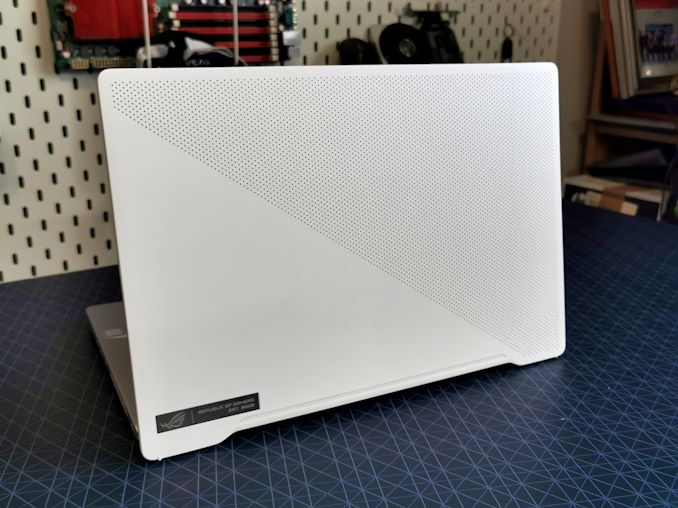
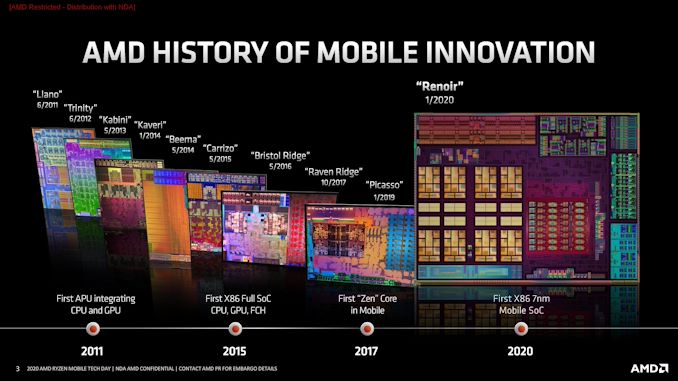
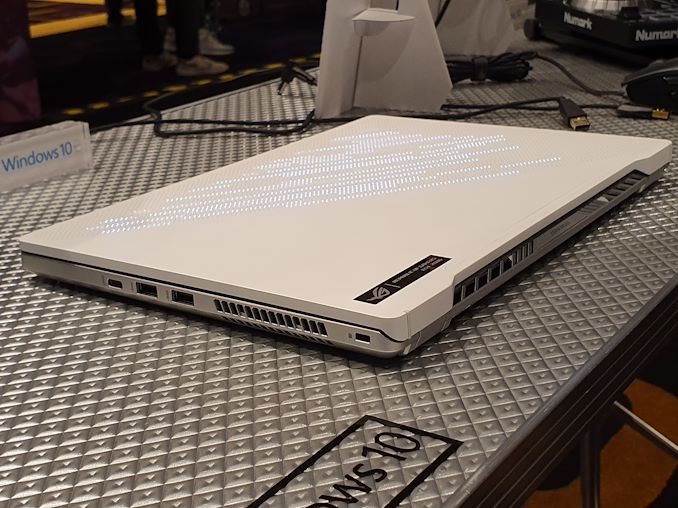
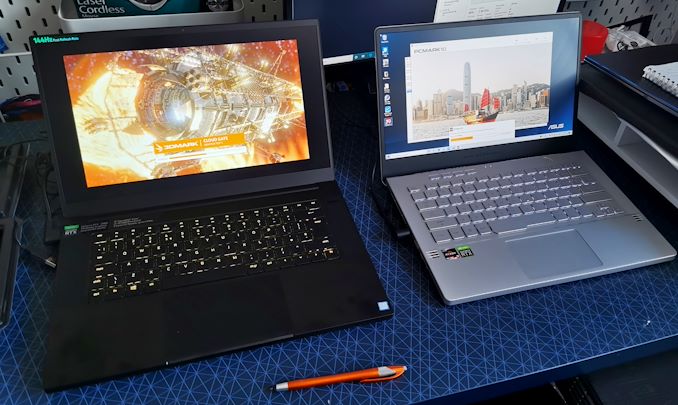








267 Comments
View All Comments
ingwe - Thursday, April 9, 2020 - link
This is very exciting! Especially those battery life numbers.shabby - Thursday, April 9, 2020 - link
Wow ya i was hoping it would at least match intel not double intels battery life lolBigMamaInHouse - Thursday, April 9, 2020 - link
CB R20 Scores are wrong Again :-)Cooe - Thursday, April 9, 2020 - link
The scores are right, they are just labeled wrong lol.SolarBear28 - Thursday, April 9, 2020 - link
@IanCutress The scores should be reversedSamus - Friday, April 10, 2020 - link
It isn't just exciting. It's shocking. AMD finally has a viable notebook CPU.Now they need to come up with something worthy against the U series for ultraportables because the current crop Ryzen U parts (like the Pro 3500U) are a tough pill to swallow since they seem to run closer to 35w under any sort of load.
Gondalf - Friday, April 10, 2020 - link
Here i can see only and AMD 8 cores SKU beating a 6 cores one. There is nothing to be shocked.Try a 8 cores Intel laptop instead, equipped with a new intel SKU and not with one shipped one year ago.
Qasar - Friday, April 10, 2020 - link
and what if the 8 core intel laptop couldnt compete with this one, then what ? would you find a way to make up some lame BS reason as to why it still lost??? come one gondalf, get a lifeGondalf - Sunday, April 12, 2020 - link
Pretty pointless to compare a 6 core cpu with a 8 core one.Moreover the article is rushed because Intel SKUs have a 15ms delay to go from idle to max turbo.
Very likely the Intel Laptop suffer of bad settings or wrong/obsolete bios. Same applies to power measures, with a 80Wh battery an Intel laptop can last around 10 hours browsing web with GPU down. My 38Wh battery give me 5 hours of the same workload, with GPU down.
My bet Intel laptop was with GPU up under the test.
So better wait less rushed reviews to judge.
Qasar - Sunday, April 12, 2020 - link
pretty pointless to try everything you can do to give intel excuses as to why they are losing gondalf, even if intel had more cores, they would still be losing, i believe zen 2 desktop vs intels desktop cpus show this, more cores for intel, and intel still looses on most tests, but yet if it was the other way around, it would be ok, and you would just bash amd for making an inferior product. either way, your just trying to come up with lame BS as to why intel lost, like most i bet, knew you would. very likely, intel just has the inferior product right now.